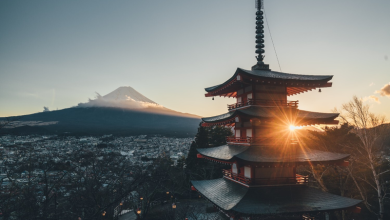
Everything You Need to Know About The Grand Canyon
The Grand Canyon is a gorge in northern Arizona that stretches for more than a mile deep. In the last 5-6 million years, the Colorado River has dug a channel through the rock, forming the Canyon. Since the previous Ice Age, people have lived in and around the Canyon. In the 1540s, Spanish explorers became the first Europeans to reach the Great Canyon. The Grand Canyon was designated a forest reserve by President Benjamin Harrison in 1893, then a national park by President Woodrow Wilson in 1919.
Where Is the Grand Canyon?
Flagstaff, Arizona, is the closest major city to the Grand Canyon, at an approximate distance of about 100 miles (160 kilometres). The Canyon is one of the world’s largest at 270 miles long, 18 miles broad, and a mile deep.
The Colorado River eroded a deep passage through the rock, forming this natural monument about five to six million years ago.
The granite in the Grand Canyon is some of the oldest that has ever been exposed in the world. Nearly two billion years of Earth’s crust may be seen in the mile-high walls. Geologists can now track the evolution of organisms over geologic time thanks to these rock strata.
Near the Inner Gorge’s bottom are the Canyon’s oldest known rocks, the Vishnu Basement Rocks. About 1.7 billion years ago, magma solidified and linked this region to the North American continent, forming the Vishnu rocks.
A new educational exhibit on the park’s South Rim allows visitors to follow the Canyon’s geological history back in time.
Native Cultures At Grand Canyon
Archaeologists have uncovered nearly 12,000 years of human habitation in the form of ruins and relics. During the last Ice Age, when huge beasts still roamed North America, prehistoric humans initially settled in and around the Canyon. Early human occupancy is evident by the presence of large stone spear points.
Read Also: Craigslist Cleveland
In the Canyon’s rock face, archaeologists have uncovered hundreds of miniature split-twig figurines dating from the 1st to 2nd millennia B.C. Deer and bighorn sheep sculptures are among the available options. According to anthropologists, the figurines may have been left in caves as part of a ritual by prehistoric hunters to ensure a successful hunt.
The Grand Canyon was previously home to ancient Pueblo people and Paiute, Navajo, Zuni, and Hopi tribes. After years of arguing, the Havasupai Tribe has finally established ownership of the Grand Canyon. The Havasupai have resided in and around the Canyon for about 800 years, based on tribal history.
As soon as the Grand Canyon was declared a reserve and then a national park. Nearly all of the Havasupai ancestral land was taken up by the government for its intended use. Famous newspapers, like The Wall Street Journal, The Los Angeles Times, and The San Francisco Chronicle, took an interest in the Havasupai’s plight. They helped them win back a significant section of federal territory in 1975.
Today, tourism provides the majority of the Havasupai’s income. With its turquoise pools and red boulders, Havasu Falls attracts roughly 20,000 tourists each year to a remote part of Grand Canyon National Park.
Grand Canyon Exploration
Europeans first reached the Grand Canyon in the 1540s under the guidance of Hopi guides. The Grand Canyon was first explored by an American soldier, botanist, and explorer Joseph Christmas Ives in 1858 during a Colorado River mapping mission. The first known geologist to investigate the Grand Canyon was American geologist John Newberry, who joined the expedition as a naturalist.
Another American soldier and adventurer, John Wesley Powell, made his way back to the area a decade later. The charts he and his team drew up depicted the Colorado River’s path through the Canyon in more detail.
Grand Canyon Village
In the 1880s, settlers began to arrive at the Grand Canyon’s rim. They were copper-seeking prospectors. Early settlers soon discovered that tourism was far more lucrative than mining for the region’s early residents and pioneers.
In 1893, President Benjamin Harrison designated the Grand Canyon as a forest reserve, giving it government protection for the first time. Grand Canyon tourism grew rapidly following the year 1901. When the Santa Fe Railroad’s Grand Canyon Village spur was finished, tourists from Flagstaff, Arizona, the closest large city, could travel from there to Grand Canyon Village on the South Rim to begin their journey into the Canyon.
While visiting the Grand Canyon in 1903, US President Teddy Roosevelt. Parts of the Grand Canyon were designated a federal game reserve by Teddy Roosevelt. A lifelong hunter who wished to preserve the area’s natural beauty for future generations. The region was designated as a National Monument in the following years.
President Woodrow Wilson established the National Park Service in 1916. The Grand Canyon National Park was the first to be designated as such three years later, in 1919.
Grand Canyon Skywalk
When Grand Canyon National Park initially opened to the public in 1919, it drew around 44,000 people. The Grand Canyon has now been visited annually by almost five million visitors from all over the world.
Among the most recent additions is the Grand Canyon Skywalk, a glass-floored cantilevered walkway suspended over the Canyon’s western rim. The Hualapai Tribe owns and operates the controversial 2007 attraction, which its detractors’ claim disrupts sacred grounds and intrudes on an otherwise pristine environment.
Increased tourism has put pressure on the Canyon’s water supply and jeopardized sacred Native American sites. The government has restricted the number of river and helicopter flights down the Grand Canyon that can be taken each year. On environmental grounds, the Navajo Nation rejected the Grand Canyon Escalade project in 2017. Which would have included hotels, shops, and a tourist gondola from Navajo property to Grand Canyon’s South Rim.


